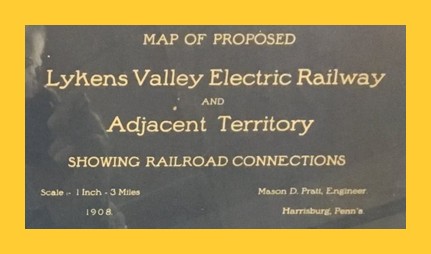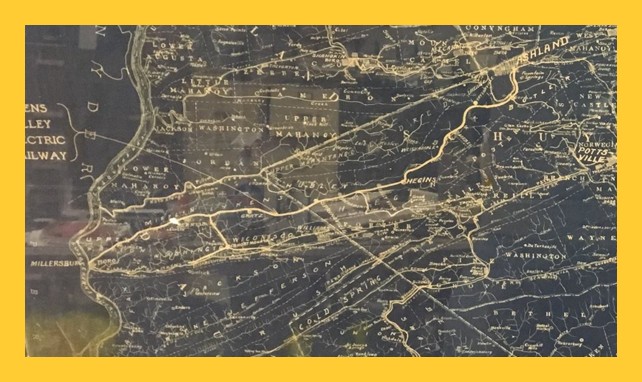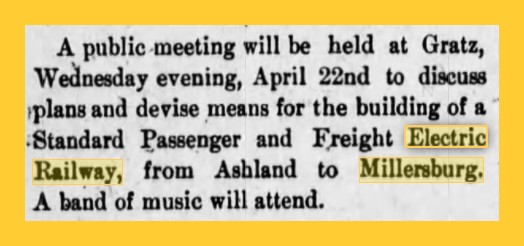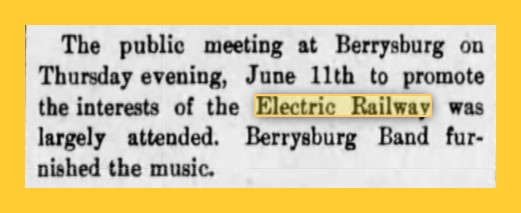A cut from a map showing a proposed electric railway from Millersburg, Dauphin County, Pennsylvania, to Ashland, Schuylkill County, Pennsylvania, 1908. In this time period “electric railway” was synonymous with “street-railway”, “trolley” and “interurban.”
The map legend indicates that this railway was to be called the Lykens Valley Electric Railway and was to have station stops in the communities of Berrysburg and Gratz in Dauphin County, and Hegins in Schuylkill County, in addition to other intermediate points between Millersburg and Ashland.
The engineer who drew the map was Mason D. Pratt of Harrisburg.
The above map is presently available at the Historical Society of Millersburg and Upper Paxton Township.
This electric railway that was proposed should not be confused with the Midland Pennsylvania Railroad which was being discussed at about the same time and afterward. The Midland was a steam railroad which had a proposed termination at Gordon, Schuylkill County. The electric railway would have been a competitor, if both were built over the same territory.
Thus far, only two newspaper mentions have been found about this proposal.
On April 2, 1908, the Elizabethville Echo published the following:
A public meeting will be held at Gratz, Wednesday evening, April 22nd to discuss plans and devise means for the building of a Standard Passenger and Freight Electric Railway, from Ashland to Millersburg. A band of music will attend.
The second item appeared in the same newspaper on June 18, 1908:
The public meeting at Berrysburg on Thursday evening, June 11th to promote the interests of the Electric Railway was largely attended. Berrysburg Band furnished the music.
So, why didn’t the electric railway proceed beyond 1908 and the proposal drawn up by engineer Mason D. Pratt?
An unexpected incident that occurred on December 15, 1908 in Williamsport, Maryland, may have had some connection to ending the Lykens Valley Electric Railway project.
The headline in the Valley Spirit, Chambersburg, Pennsylvania, December 23, 1908, read:
FOUR KILLED WHEN BRIDGE COLLAPSED
Williamsport Bridge About Completed When it Gave Way and Workmen Were Dashed to Death in River Below
On December 30, 1908, the Gettysburg Compiler, featured the following:
THE WILLIAMSPORT DISASTER
Mason D. Pratt, Engineer, Blamed by Coroner’s Jury
The coroner’s jury inquiring into the cause of the Williamsport bridge disaster, and the death of five workmen, among others James G. Myers of Bendersville, have concluded their work and made a report which puts the blame on Mason D. Pratt, the Harrisburg engineer, well known in this place….
The jurors aforesaid do further say upon their oaths that in their judgment the accident was caused by the constructors of the concrete piers being permitted by the engineer to use a grade of sand inferior to that provide for in the contract, and in authorizing or permitting the structural iron work and traveler to be placed upon and in part supported by said pier number ten while it was yet too green to be used for that purpose, as a result of which the up stream pedestal on pier number ten gave way under the strain placed upon it precipitating to the ground the weight that it carried and causing thereby the death of the men at work.
Mr. Pratt says: “I consider the verdict unfair and not in accordance with the evidence.”
Whether or not proceedings will be instituted against Mr. Pratt by the Maryland authorities has not been determined.
No charges were made against Pratt for the bridge collapse.
On November 8, 1909, Public Opinion, Chambersburg, Pennsylvania, reported that Mason D. Pratt, “who drew the plans for the new Williamsport bridge, has… filed suit in Hagerstown to recover $3,353.83 balance, which he claims the Washington and Berkeley Bridge Company owe him for making surveys of the bridge, drawing plans, supervising the work, etc. The full amount of his claim was $6,853.83. The company paid him $3,500.”
About 1927, when he was about 63 years old, Pratt moved to the west coast.
Aside from designing bridges, Pratt also wrote the book, Street-Rail Roadbed, published in 1901. It was considered the definitive work in the design and construction of street-railways. Apparently, he was the right person to be involved in the design and construction of the Lykens Valley Electric Railway.
When Pratt died in 1947, his obituary appeared in the Harrisburg Telegraph, November 1, 1947:
MASON D. PRATT
Mason D. Pratt, 83, former consulting engineer with the old Pennsylvania Steel Company, died October 14, at his home in Los Angeles, California….
A specialist in bridge designing, he also designed the South Cameron Street power plant for the old Central Pennsylvania Traction Company, the tunnel leading from the plant to the river and the railways car barns on North Cameron Street….
It is more likely that the difference in marketing the two projects, i.e., the Lykens Valley Electric Railway and the Midland Pennsylvania Railroad, resulted in moving the latter forward, rather than the legal troubles of the engineer of the former.
It is not known at the time of this writing whether Pratt had any involvement with the Midland Pennsylvania Railroad .
Additional information is sought on the Lykens Valley Electric Railway project.
___________________________________
Photo of map from Historical Society of Millersburg and Upper Paxton Township. Contact through Facebook or web site.
Corrections and additional information should be added as comments to this post.



